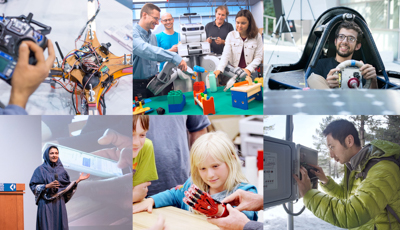CITRIS "shortens the pipeline" between world-class laboratory research in science and engineering and the creation of startups, companies, and …
Uncategorized
August 2009 Newsletter
CITRIS "shortens the pipeline" between world-class laboratory research in science and engineering and the creation of startups, companies, and …
Why Herd Cats When You Can Swarm a Network? Santa Cruz Researchers Employ New Tech to Track Pumas
A group of biologists at UC Santa Cruz is employing
sensor and communications technology, partially supported by CITRIS,
that they have built into radio collars to better understand the dynamics of the mountain lions that live in
the Santa Cruz Mountains.
June 2009 Newsletter
CITRIS "shortens the pipeline" between world-class laboratory research in science and engineering and the creation of startups, companies, and …
CITRIS helps City of San Francisco Evaluate Community Safety Camera Program
Working on behalf of the city of San Francisco, UC Berkeley and
CITRIS-affiliated researchers recently released a comprehensive
evaluation of the city's public surveillance camera system, completed over seven
months.
Listening to the Price of Power: A New Generation of Thermostats can Save California Billions
A team of CITRIS-backed engineers, working with state regulators,
private industry, and policy experts, has fashioned a low-cost solution
to a billion-dollar energy problem.
April 2009 Newsletter
CITRIS "shortens the pipeline" between world-class laboratory research in science and engineering and the creation of startups, companies, and whole …
Taming Buildings a la Carte
Mobile commissioning cart permits quick evaluation and analysis of buildings’ efficiency.
February 2009 Newsletter
CITRIS "shortens the pipeline" between world-class laboratory research in science and engineering and the creation of startups, companies, and …
December 2008 Newsletter
Dear Friends of CITRIS,
In this newsletter we are pleased to highlight two exciting projects that each address pressing needs for California and exemplify …
What Art Can Do: The Transformative Work of Sharon Daniel
Artist Sharon Daniel helps give disenfranchised groups, such as women prisoners and shantytown dwellers, access to technology to document their experiences.
October 2008 Newsletter
Dear Friends of CITRIS,
CITRIS’s projects extend far beyond just the “technology push” elements of our mission. This issue of the newsletter shows how …
Navigating Climate Change: Tools for the UN Summit and Beyond
The CITRIS conference in June in Copenhagen focused on the
relationships among public policy, the role of business, and
technological means that could be used to fight global warming.
Too Darn Hot: Thermoelectric Power Generation
New materials under development by Ali Shakouri,
Associate Professor of Electrical Engineering at the University of
California, Santa Cruz, stand to convert energy now wasted as heat into a reusable new source of
electricity.
August 2008 Newsletter
Dear Friends of CITRIS,
I recently returned from a conference in Copenhagen feeling
hopeful about the ability and willingness of some of the …
June 2008 Newsletter
Dear Friends of CITRIS,
Can CITRIS reduce the costs of fuel to consumers? The two articles in this month's newsletter suggest we just might. Certainly …
Squeezing Through the Solar Bottleneck: Predicting Direct Solar Irradiance
Within 15 years, solar power could produce as much as 15 percent of all the energy consumed in California. However, given our current inability to predict reliably the amount of direct solar irradiance available to the state’s energy grid at least a day or two in advance, utility companies cannot risk relying on this highly productive source. CITRIS researchers are working to solve that problem.
Smart HCCI Cars: They’ll Talk to Themselves, and to the Pump
CITRIS researchers are developing engines that use 15 percent less fuel than gas engines and emit only 30 percent of the NOx of a typical diesel engine. Thus, they appear to combine the best of both engines. Except for one problem: temperature variations.
April 2008 Newsletter
Dear Friends of CITRIS:
The two projects featured in our newsletter demonstrate the tremendous power of
technology for social impact. It is exciting and …
Demand Response Presentations Online
The Demand Response Enabling Technology Development project (DR ETD) held a meeting of its Technical Advisory Committee on February 19, 2008. Presentations of this meeting […]
Monitoring Particulates Against the Range of Light
Shawn Newsam is developing a network of several dozen cameras that can
collect data and possibly analyze air particulates around the Central
Valley. The project could provide a quick, easily accessible way to
evaluate local air quality in real time.
Energy Security with Advanced High Temperature Reactors
Smaller, hotter, safer, and more versatile nuclear power plants may help address environmental and security concerns.
February 2008 Newsletter
Dear Friends of CITRIS:
Let's hope the first decades of this century will be remembered for our success at diluting our dependence on carbon-intensive …
How (Much) To Trust Wikipedia
Since anyone in the world can edit articles on Wikipedia, one of the most visited sites on the web, how do we know how to trust its content? One CITRIS researcher has a method.
